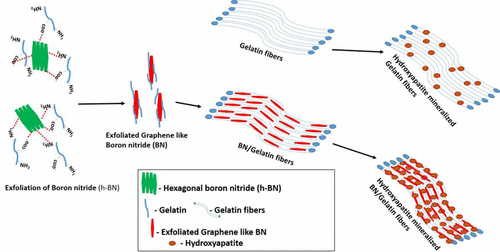当前位置:
X-MOL 学术
›
ACS Appl. Mater. Interfaces
›
论文详情
Our official English website, www.x-mol.net, welcomes your
feedback! (Note: you will need to create a separate account there.)
Design of Boron Nitride/Gelatin Electrospun Nanofibers for Bone Tissue Engineering
ACS Applied Materials & Interfaces ( IF 8.3 ) Pub Date : 2017-09-21 00:00:00 , DOI: 10.1021/acsami.7b13199 Sakthivel Nagarajan 1, 2 , Habib Belaid 1, 3 , Céline Pochat-Bohatier 1 , Catherine Teyssier 3 , Igor Iatsunskyi 4 , Emerson Coy 4 , Sébastien Balme 1 , David Cornu 1 , Philippe Miele 1 , Narayana S. Kalkura 2 , Vincent Cavaillès 3 , Mikhael Bechelany 1
ACS Applied Materials & Interfaces ( IF 8.3 ) Pub Date : 2017-09-21 00:00:00 , DOI: 10.1021/acsami.7b13199 Sakthivel Nagarajan 1, 2 , Habib Belaid 1, 3 , Céline Pochat-Bohatier 1 , Catherine Teyssier 3 , Igor Iatsunskyi 4 , Emerson Coy 4 , Sébastien Balme 1 , David Cornu 1 , Philippe Miele 1 , Narayana S. Kalkura 2 , Vincent Cavaillès 3 , Mikhael Bechelany 1
Affiliation

|
Gelatin is a biodegradable biopolymer obtained by collagen denaturation, which shows poor mechanical properties. Hence, improving its mechanical properties is very essential toward the fabrication of efficient nontoxic material for biomedical applications. For this aim, various methods are employed using external fillers such as ceramics or bioglass. In this report, we introduce boron nitride (BN)-reinforced gelatin as a new class of two-dimensional biocompatible nanomaterials. The effect of the nanofiller on the mechanical behavior is analyzed. BN is efficiently exfoliated using the biopolymer gelatin as shown through Fourier transform infrared (FTIR) spectroscopy and X-ray diffraction (XRD). The exfoliated BN reinforces gelatin electrospun fibers, which results in an increase in the Young’s modulus. The Electrospun Mats (ESM) are stable after the glutaraldehyde cross-linking, and the fibrous morphology is preserved. The cross-linked gelatin/BN ESM is highly bioactive in forming bonelike hydroxyapatite as shown by scanning electron microscopy. Due to their enhanced mineralization ability, the cross-linked ESM have been tested on human bone cells (HOS osteosarcoma cell line). The cell attachment, proliferation, and biocompatibility results show that the ESM are nontoxic and biodegradable. The analysis of osteoblast gene expression and the measurement of alkaline phosphatase activity confirm that these materials are suitable for bone tissue engineering.
中文翻译:

氮化硼/明胶电纺纳米纤维的骨组织工程设计
明胶是通过胶原变性获得的可生物降解的生物聚合物,其显示出较差的机械性能。因此,改善其机械性能对于制造用于生物医学应用的有效的无毒材料非常重要。为了这个目的,使用诸如陶瓷或生物玻璃之类的外部填料的各种方法被采用。在本报告中,我们介绍了氮化硼(BN)增强的明胶,它是一类新型的二维生物相容性纳米材料。分析了纳米填料对机械性能的影响。如通过傅立叶变换红外(FTIR)光谱和X射线衍射(XRD)所示,使用生物聚合物明胶可有效去除BN。脱落的BN增强了明胶电纺纤维,导致杨氏模量增加。戊二醛交联后,静电纺垫(ESM)保持稳定,并保留了纤维形态。交联的明胶/ BN ESM在形成骨状羟基磷灰石方面具有很高的生物活性,如扫描电子显微镜所示。由于其增强的矿化能力,已在人骨细胞(HOS骨肉瘤细胞系)上测试了交联的ESM。细胞附着,增殖和生物相容性结果表明,ESM无毒且可生物降解。对成骨细胞基因表达的分析和碱性磷酸酶活性的测定证实了这些材料适用于骨组织工程。交联的明胶/ BN ESM在形成骨状羟基磷灰石方面具有很高的生物活性,如扫描电子显微镜所示。由于其增强的矿化能力,已在人骨细胞(HOS骨肉瘤细胞系)上测试了交联的ESM。细胞附着,增殖和生物相容性结果表明,ESM无毒且可生物降解。对成骨细胞基因表达的分析和碱性磷酸酶活性的测定证实了这些材料适用于骨组织工程。如扫描电子显微镜所示,交联的明胶/ BN ESM在形成骨状羟基磷灰石方面具有高生物活性。由于其增强的矿化能力,已在人骨细胞(HOS骨肉瘤细胞系)上测试了交联的ESM。细胞附着,增殖和生物相容性结果表明,ESM无毒且可生物降解。对成骨细胞基因表达的分析和碱性磷酸酶活性的测定证实了这些材料适用于骨组织工程。
更新日期:2017-09-21
中文翻译:

氮化硼/明胶电纺纳米纤维的骨组织工程设计
明胶是通过胶原变性获得的可生物降解的生物聚合物,其显示出较差的机械性能。因此,改善其机械性能对于制造用于生物医学应用的有效的无毒材料非常重要。为了这个目的,使用诸如陶瓷或生物玻璃之类的外部填料的各种方法被采用。在本报告中,我们介绍了氮化硼(BN)增强的明胶,它是一类新型的二维生物相容性纳米材料。分析了纳米填料对机械性能的影响。如通过傅立叶变换红外(FTIR)光谱和X射线衍射(XRD)所示,使用生物聚合物明胶可有效去除BN。脱落的BN增强了明胶电纺纤维,导致杨氏模量增加。戊二醛交联后,静电纺垫(ESM)保持稳定,并保留了纤维形态。交联的明胶/ BN ESM在形成骨状羟基磷灰石方面具有很高的生物活性,如扫描电子显微镜所示。由于其增强的矿化能力,已在人骨细胞(HOS骨肉瘤细胞系)上测试了交联的ESM。细胞附着,增殖和生物相容性结果表明,ESM无毒且可生物降解。对成骨细胞基因表达的分析和碱性磷酸酶活性的测定证实了这些材料适用于骨组织工程。交联的明胶/ BN ESM在形成骨状羟基磷灰石方面具有很高的生物活性,如扫描电子显微镜所示。由于其增强的矿化能力,已在人骨细胞(HOS骨肉瘤细胞系)上测试了交联的ESM。细胞附着,增殖和生物相容性结果表明,ESM无毒且可生物降解。对成骨细胞基因表达的分析和碱性磷酸酶活性的测定证实了这些材料适用于骨组织工程。如扫描电子显微镜所示,交联的明胶/ BN ESM在形成骨状羟基磷灰石方面具有高生物活性。由于其增强的矿化能力,已在人骨细胞(HOS骨肉瘤细胞系)上测试了交联的ESM。细胞附着,增殖和生物相容性结果表明,ESM无毒且可生物降解。对成骨细胞基因表达的分析和碱性磷酸酶活性的测定证实了这些材料适用于骨组织工程。











































 京公网安备 11010802027423号
京公网安备 11010802027423号